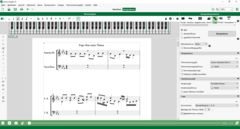tonica fugata
| tonica fugata
|
|
|---|---|
|
|
|
 Tonica fugata main screen 13 |
|
| Basic data
|
|
| developer | capella-software AG |
| Current version | 13.0-01 (March 6, 2019) |
| operating system | Windows , macOS |
| category | Music notation program |
| License | proprietary |
| German speaking | Yes |
| capella-software.com/de | |
tonica fugata is a composition program for Microsoft Windows and macOS , which is distributed by the company capella-software from Söhrewald ( district of Kassel ). It teaches the basics of musical composition theory and independently creates compositions (tone sets, variations, canons and fugues) on entered melodies or themes. tonica fugata is designed for self-study.
The program was originally developed under the name tonica as a learning and application program for the areas of chord theory , music theory and composition . With version 4.0 an automatic composition for tone sentences was integrated. Since then it has been expanded to include other musical forms and styles. With the composition of Fugen from version 9.0, the name was changed to tonica fugata. Since version 13.0 tonica fugata is also available for macOS. At the same time, the score display and score processing was adapted to the capella music notation program and the composition algorithm was expanded to include any number of voices.
In addition to tonica fugata, there is also a restricted version called tonica pop , with which, among other things, no fugue composition is possible.
Range of functions
tonica fugata deals with tasks that are part of the theory of music at schools and universities:
- The harmonic analysis and voice-leading analysis of tone sets in step theory and function theory
- The addition of a second accompanying voice to a given melody
- The creation of a polyphonic set of notes for a given melody or a bass line ( figured bass )
- The play around a theme or the voices of a musical movement with figural variations
- The creation of accompanying patterns in various dance and entertainment styles
- The creation of canons in strict form and as circular canons
- The composition of fugues on a given theme
The program solves the above tasks independently based on the user's specifications, for example on an entered topic. It uses style imitation: The user can influence the result by choosing a harmonization style or a variation style. This is a personal style (e.g. Johann Sebastian Bach) or genre style (e.g. jazz). The following harmonization styles are currently predefined in tonica fugata:
In addition to these predefined styles, the user can create his own harmonization styles by specifying appropriate music examples.
The program offers different styles based on the style of the partitas by Johann Pachelbel and the preludes by JS Bach.
Mode of action
tonica fugata uses algorithmic composition methods . As technology are artificial neural networks are used, the structure and weights on learning concrete examples (eg. B. Choräle of JS Bach) to be adjusted.
Instead of working with fixed rules and thus limiting the search space, tonica fugata does without a fixed set of rules, apart from a few basic rules such as the ban on parallel fifths . Instead, the program solves the tasks by performing a discrete time series analysis for the sequence of tones, harmonies and motifs in the learning examples and thereby training the neural networks. Predictions for new melodies and themes are then derived from the knowledge that is stored in the neural networks. The application of this knowledge can be controlled in a targeted manner by chance, which leads to different solutions being generated for an input.
tonica fugata thus follows the working method of a composer, who in principle orients himself to rules, but follows his musical intuition to a far greater extent and draws on his wealth of experience and the works of musical tradition.
Joint composition
The fugue is one of the most complex and technically demanding forms in music, with which many important composers have grappled. The art consists in creating a self-contained composition from little basic material (subject and counterpoint ). The topic appears again and again in a different form (e.g. as a reversal , augmentation or narrowing ).
tonica fugata bases a fugue on a form scheme that defines the rough structure of the fugue. Based on this form scheme and the given theme, the program creates the theme material from which the joint is finally put together. tonica fugata offers different form schemes to choose from, some based on the fugues of the Well-Tempered Clavier by JS Bach.
commitment
tonica fugata pursues the approach of exploratory learning : The user is not guided step by step to the finished musical result, but should independently gain experience and learn to compose based on the analysis of his own compositions or the compositions generated by the program. Beginners and amateurs are therefore required to have a certain degree of certainty with regard to the aesthetic assessment of the musical results produced by tonica fugata. For experienced users and professional composers whose compositions can be stylistically assigned to tonal music or jazz, tonica fugata is a suitable construction kit from which they can draw material for their own compositions.
Interfaces
tonica fugata uses a proprietary file format, but imports and exports data in MIDI format, CapXML format and MusicXML format. A direct interface to the capella music notation program from the same manufacturer allows further editing of the compositions. Notes can be entered using the computer keyboard, the mouse or a MIDI keyboard.
See also
literature
- ↑ Version history. capella-software.com, accessed on March 6, 2019 .
- ↑ Dominik Hörnel: Learning musical structures and styles with neural networks. ISBN 3-8265-7576-8 .
- ↑ Daniel Frey, Dominik Hörnel: Handbook for tonica fugata ( PDF )
- ↑ Hans-Ulrich Werner: Small fugue theory on tonica fugata ( PDF )